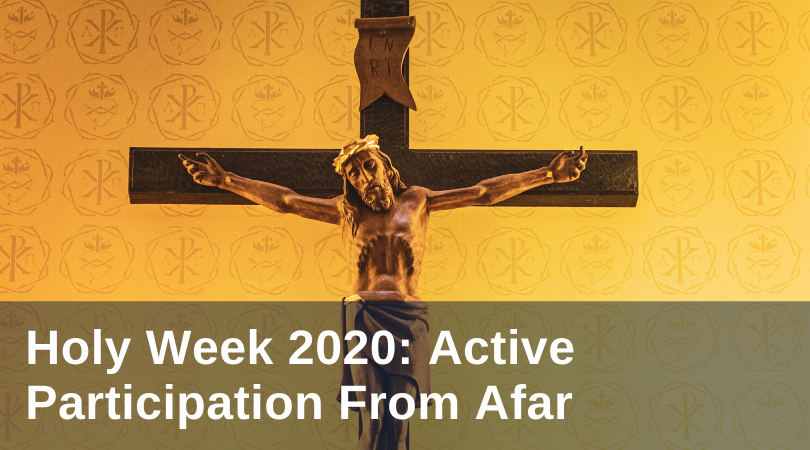
Under the pall of the COVID-19 pandemic, the lives of people around the globe have been radically upended in countless ways. The Church shares in this upheaval, as all dioceses of the United States have canceled public Masses and are wrestling with how best to continue dispensing the sacraments—especially Confession and Anointing of the Sick—while observing necessary health precautions. It’s clear that the celebrations of Holy Week will necessarily be very different in 2020, with the rituals unfolding in empty churches. (On the bright side, with stay-at-home orders, there should be record “attendance” at the Triduum via livestream!)
So what will our Holy Week liturgies look like during this time of isolation? Recent decrees sent by the Vatican to bishops’ conferences throughout the world have provided some guidance. The following overview attempts to highlight what those of us watching from home can expect to see, while also recommending things we can do to participate more fully (in addition to these helpful suggestions).
Palm Sunday
The most noticeable absence will the blessing of palms. Typically there are three different options for beginning the Palm Sunday Mass, but this year the Vatican has asked parishes to use the simplest option, which omits the blessing and distribution of palms (presumably for concerns about COVID-19’s ability to survive on surfaces). Cathedrals are permitted to do a simplified blessing of palms, but even then, palms will likely not be widely distributed until after this crisis, if at all.
Palms rank alongside ashes as the most popular sacramental “souvenirs” of the liturgical year, so they will be sorely missed. But even without fresh palms there are potential options: traditional liturgical flora for this occasion in other parts of the world include yew, willow, or olive branches—basically, whatever has been readily available. After all, the Gospel passages from Matthew and Mark that describe the entry into Jerusalem refer simply to branches cut from trees, or “leafy branches.”
If you have access to ferns or some other leafy branches, feel free to hold those during Mass. Dried, blessed palms from previous years can certainly be pressed into service again. In places where spring has not yet sprung, evergreen branches—even branches from artificial Christmas trees—also adequately convey the sense of greenery held aloft to herald the arrival of Jesus before his Passion. (Just watch out for sap on the furniture!)
The Passion Gospel is the other extraordinary element on Palm Sunday. Depending on how many ministers are present at the livestreamed Mass you’re watching, the Passion Gospel (from Matthew this year) may be divided into the familiar style of a narrator and a couple voices, or it may be read straight through. If a parish employs the former, then providing some resource for the online congregation to join in the traditional “crowd” parts would be extremely helpful. In addition, worshipers at home can kneel in silence, as we normally do, immediately after the words “Jesus cried out again in a loud voice, and gave up his spirit” (Matthew 27:50).
Holy Thursday
The prescribed changes to the Mass of the Lord’s Supper are the omission of both the footwashing rite (which is optional to begin with) and the transfer of the Blessed Sacrament to the altar of repose at the conclusion of Mass. These omissions are necessitated for reasons of hygiene and the lack of a congregation.
For those familiar with the Holy Thursday liturgy, the solemn procession to the altar of repose is probably the most moving and memorable moment. Although nothing can truly replace it, spending some time in silent prayer in a quiet corner of your home by candlelight might approximate the sense of keeping watch with our Lord into the night. Parishes running a livestream could also remain focused on the tabernacle for a length of time after the liturgy to encourage such watchfulness.
Good Friday
The first half of the Good Friday service will occur much like normal, with the Passion narrative from the Gospel of John following the same dynamics outlined above for Palm Sunday.
One significant change will actually be an addition: at the conclusion of the usual ten Solemn Intercessions for various needs of the faithful and of the world, the Holy See has asked all bishops to add a special eleventh intention “for the sick, the dead, and for all who feel lost or dismayed” amidst the pandemic. The wording will vary from diocese to diocese, but all the faithful can anticipate that moment of extraordinary solidarity.
This year the Showing of the Holy Cross will likely be simplified, with the cross being unveiled without a procession. The key change is in the Adoration of the Holy Cross—it will merely be displayed for the online congregation to venerate visually, since the cherished practice of a stream of the faithful approaching to physically reverence the crucifix is impossible. Even the few ministers present at the service cannot all safely venerate it with the traditional kiss.
Every family participating from home can plan to have either a crucifix or plain cross set before them during the service. It could even be covered in a cloth or towel (ideally purple) and unveiled at the proper time. Then a kiss or another sign of reverence would be most appropriate to express our devotion to this icon of the True Cross and the Death of our Savior.
Holy Saturday
Holy Saturday is a unique period of sober anticipation. In many ways, it’s already tailored for these strange times we find ourselves in: only Confession, Anointing of the Sick, and viaticum (Communion to the dying) are ever permitted on this day.
It also offers us a beautiful opportunity for a deep reflection on isolation and death amidst the specter of COVID-19. Christ’s time in the tomb and descent into hell were a profound experience of lifelessness by the Son of God—all so that he might definitively conquer death on our behalf. In a culture where we tend to avoid public reminders of death, we would do well to reflect on our own mortality, just as we were exhorted to do at the beginning of Lent (“Remember you are dust, and to dust you shall return”). During our extended Holy Saturday and in the years to come, let us strive to be unafraid of death, secure in the hope of the Resurrection.
Easter Vigil
The Great Vigil, that most glorious of liturgical celebrations, will undergo a necessary degree of impoverishment this year. Per the guidance of the Vatican, the blazing Easter fire and the procession with the “Light of Christ” are omitted, and Baptisms will be postponed until public Masses can resume.
On the other hand, the Holy See has asked priests still to only celebrate the Vigil in the actual church building (as opposed to in a smaller chapel or in the rectory). The Vigil should also still take place at dark, and the sublime chant of the Exsultet should still resound in most of our churches and livestreams.
The faithful who wish to follow the Vigil on-screen can prepare candles (either to be held or placed in stands) and light them during the lighting of the Paschal candle. Any artificial lighting could be kept to a minimum throughout the singing of the Exsultet, allowing candle flames to scatter the darkness in our homes as we hear how the Easter candle symbolizes the risen Christ—the “pillar of fire” that “banished the darkness of sin” from the world.
From the days of the Early Church, the full initiation of catechumens via Baptism, Confirmation, and reception of the Eucharist has been a highlight of the Easter Vigil. Its absence will be felt poignantly by the universal Church this year, and it constitutes a great individual burden for the elect and their sponsors who have been longing for this moment. We would do well to remember them in prayer as their personal experience of Holy Saturday continues.
Although the font will not be blessed at the Vigil, we will still be asked to renew our baptismal promises. For those of us fortunate enough to have holy water at home, we can plan to bless ourselves at this time as a reminder of our Baptism. Even without holy water, our “I do” to the questions resolutely affirms our belonging to Christ.
Easter Sunday
At Mass on Easter Sunday, the Creed is replaced by this same renewal of baptismal promises—we recommit ourselves to the Christian life amidst trials both earthly and spiritual.
There is no denying that this Holy Week will leave us wanting. Nothing can replace the incarnational quality of physically gathering to celebrate the liturgy and the sacraments. Yet beyond the virtual connections we are navigating, our communion as the Body of Christ remains very real. We know the Holy Sacrifice of the Mass continues, and that God always offers us an adequate source of grace.
The liturgy is meant to equip us to spread the joy of the Gospel out beyond the church doors, to wherever we are in the world. Our mission is not ended, and the words of Pope St. John Paul II are no less true: “We are an Easter People and ‘Alleluia’ is our song!”
Like what you read? Submit your email below to have our newest blogs delivered directly to your inbox each week.
Featured image Mateus Campos Felipe on Unsplash.


